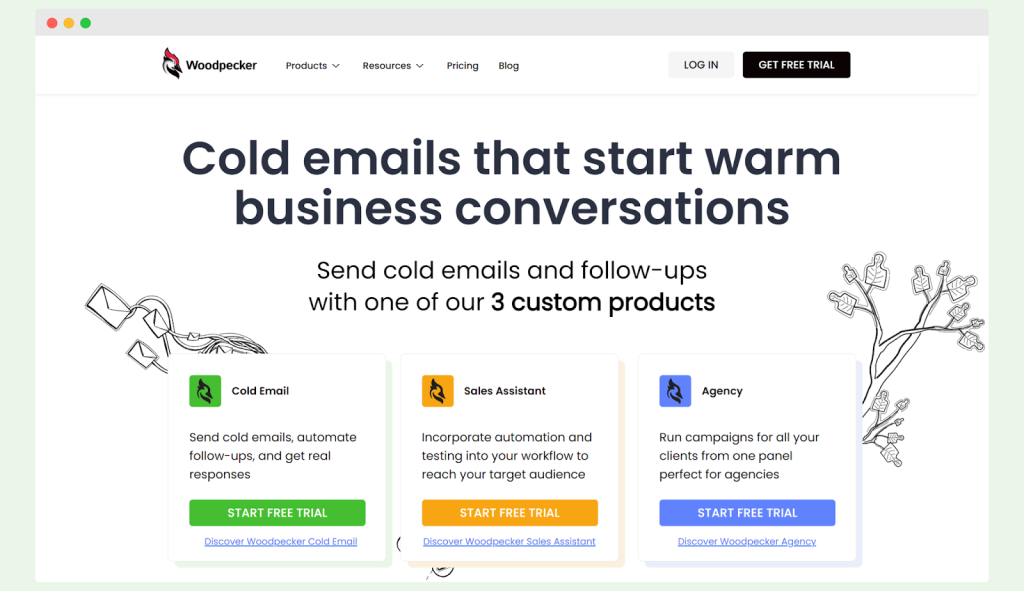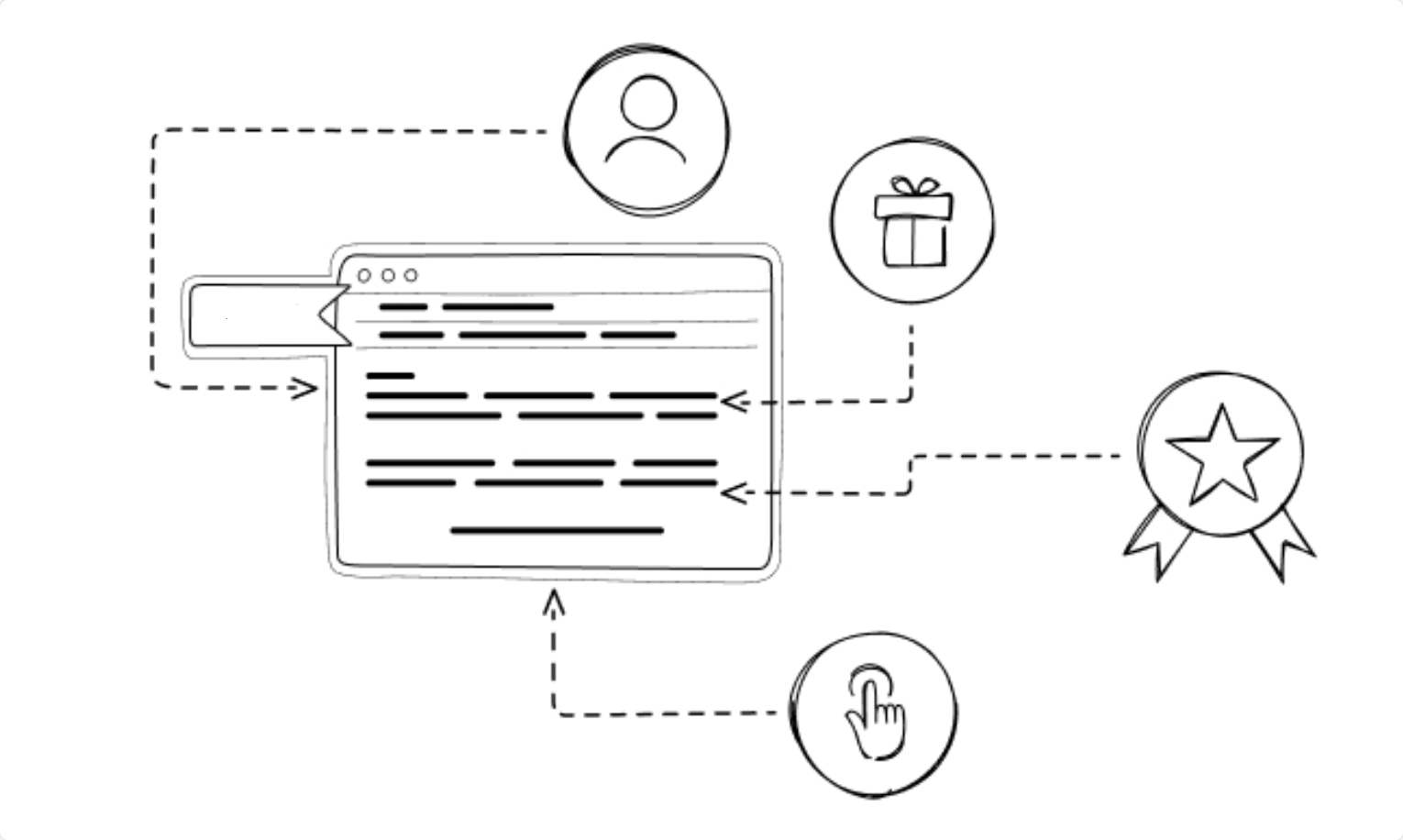Want to turn strangers into paying customers?
This is your roadmap, and we’re keeping it simple – showing you the straight-up way to write emails and and get results from them.
With tips on using tools like Woodpecker and advice on writing outbound emails, your efforts will pay off.
What is outbound email?
Outbound emails are when a company sends emails to people who didn’t ask for them. These unsolicited emails let companies tell potential or current customers about their products, services, or news updates.
They hope the outbound emails will get people interested and help sell more. Even though people didn’t sign up to get the emails, companies send them out to try and grab their attention.

Source: designs.ai
Outbound vs. inbound email marketing – key differences and similarities
Even though they seem to be similar, they are two different ways of communicating.
Initiation of contact
📧 Outbound emails – companies send these to people who didn’t opt in for them. They want to make their mark from scratch, hoping to get people interested in what they offer.
📩 Inbound emails – they come after someone shows interest. Maybe they asked a question or signed up for something. The company replies to keep the conversation going.
Goal and approach
📧 Outbound emails – the main aim is to introduce the company or its products to new people. They’re reaching out, trying to start a conversation.
📩 Inbound emails – here, the goal is to build on interest already shown. It’s deepening the conversation with people who have already taken a step towards the company.
Impact on audience relationship
📧 Outbound emails – they cast a wide net. The idea is to turn average people who never heard of the company into interested leads by catching their interest.
📩 Inbound emails – these emails strengthen connections. They’re for people who have already shown they’re curious and want to know more.
Strategic integration
📧 Outbound emails – part of a bigger plan to get new leads. Companies send these hoping to find new people to talk to.
📩 Inbound emails – they make the bond with the audience stronger. By sending these, companies follow up on the steps people have already taken towards them.
The benefits of using outbound email marketing for sales
Outbound email marketing may give more benefits than you can think of. Check them out:

Source: designs.ai
Direct communication with the target audience
Outbound email cuts straight to the chase as it lands directly in the inboxes of potential customers. It’s a direct line to people who might be interested in what you’re offering.
With each message sent, companies start conversations with recipients who have the power to respond if they’re intrigued. The usual search for interested customers turns into a straightforward path, inviting them to engage on the spot.
Personalization
Outbound email lets you add a personal touch to each message. You can match the email content with what each customer likes or needs.
It feels like you’re talking directly to them, not just sending the same email to everyone.
When customers see something that catches their interest, they’re more likely to pay attention and respond.
📚 Read: How Does Personalization Affect Cold Email Deliverability?
Lead generation
Outbound email is a great fit for finding potential customers, known as leads.
It’s like fishing – you cast your net wide to see who might be interested in what you’re offering.
With each email, you get a chance to attract people’s attention, and convince them to learn more about your product or service. It’s a straightforward way to see who might want to buy what you’re selling and to turn curious readers into leads ready to hear more.
Cost-effective communication
Instead of spending a lot on ads or marketing campaigns, sending emails directly to an email list keeps your marketing costs low.
However, it’s important to avoid sending unsolicited emails that could be marked as spam.
By carefully managing your email list and respecting recipients’ preferences, you can be sure your messages reach the right people without wasting resources.
Your business will communicate effectively with an eye on the budget. 👀
Automation and scalability
You can set up emails to send on their own, like follow-up messages or sequences, without having to do it manually every time.
You can keep in touch with lots of people at once, and also save time and effort.
With automation, you can easily handle more emails as your list grows, and no one gets left out. This setup helps your email tasks run smoothly as your business grows, keeping up with all your contacts without extra work.
Detailed analytics and tracking
Businesses can see which emails people like and which ones they don’t. It helps them write better emails in the future, which is good for their strategy, including inbound email marketing. They learn how to engage people better and get them interested.
For people receiving emails, this means they get more emails that they actually find interesting or useful. So, when someone checks their inbox, they find emails that matter to them.
It’s a win-win for both sides.
Educational content sharing
It’s a good move in content marketing. Educational content sharing works well with both inbound and outbound email strategies.
You can teach something new or show how to solve a problem – it’s a chance to show expertise and build trust among the recipients. A business then stands out and keeps people interested.
Do this for both emails and social media marketing channels to keep the coherent message across the platforms.
For the people getting these emails, there’s a big benefit as well. They get helpful and interesting information that can make a difference in their day or even their life. It’s not just another ad or sales pitch. Instead, it’s something they can use.
How to create an outbound email campaign?
If you’re about to launch your outbound email campaigns, there are a few things worth considering.
01 Define your campaign goals
When you start an outbound email campaign, the first step is to define your campaign goals. You decide what you want to achieve with your emails.
The goals guide everything from what you write in your emails to who you send them to.
For example:
- If your goal is to get more people to visit your website, your emails might include links to interesting pages or blog posts.
- If you’re trying to increase sales, your emails could have special offers or info about your products.
- If you want to boost awareness about your brand, you might share stories about your business or helpful tips related to what you do.
Objectives help salespeople and marketers focus their efforts. They ensure that both inbound and outbound email strategies work together for the best results.
02 Create a separate email domain
When setting up an outbound email campaign, create a separate email domain. It keeps your main business email safe and reduces the chance of your important emails ending up in the spam folder.
When you reach out to potential customers who haven’t yet expressed interest in your product or service, there’s a higher risk of your emails being marked as spam.
By using a separate domain for these outreach campaigns, you protect your company’s main email reputation. Your emails sent to people who have already shown they’re interested in what you have to offer, through either inbound activities or direct inquiries, will more likely arrive safely in their inboxes.
03 Grab a cold email outreach tool
A cold email outreach tool is helpful for sending a promotional email to a potential customer who might want to buy something from you but doesn’t know about your business yet.
The tools let you send an email to an extensive list of potential customers without having to do it one by one. Plus, you can see which of your emails people open and which ones make them want to learn more about what you’re selling.
It saves you time so you can focus on making your email interesting and fun to read, which can help build brand awareness with your target audience.
A tool that comes in handy is Woodpecker. It’s a platform for sending cold emails, great for boosting your outbound email strategy.
 All thanks to the features like:
All thanks to the features like:
🔴 Deliverability capabilities – monitor deliverability metrics, personalize messages, and analyze bounce reasons for successful email campaigns. Also, no need to worry about your email going to the spam folder.
🔴 Multichannel outreach – Woodpecker combines email, LinkedIn, and call sequences that can make your email efforts more diverse and effective.
🔴 Advanced tracking – keep an eye on bounce rates, reply rates, click rates, open rates, and more.
🔴 Integrations – connect Woodpecker with other tools – it takes only a few clicks. The process is simple, and you can use your favorite platforms immediately.
🔴 Email verification – Woodpecker checks your email address list for invalid addresses before sending your campaign to reduce unwanted email addresses.
04 Identify your target audience and create a prospect list
It’s figuring out who is most likely to want what you’re selling and then making a list of these potential users.
In outbound email marketing, knowing your audience is key. Think about the users who need your product or service the most. What are their interests? What problems can you solve for them?
Having a well-researched prospect list boosts your chances of getting a good response from your outbound email marketing efforts.
05 Create compelling email marketing content
Your content needs to catch the attention of your potential customers and encourage them to take action, such as making a purchase or responding to your message.
In outbound sales, you might be reaching out to someone for the first time, so your message needs to make a strong impression. Whether introducing a new product, offering a special deal, or sending an abandoned cart email, your content should be clear, engaging, and persuasive.
An example of an abandoned cart email.
🟢 Do:
Hey there! Noticed you left some awesome items in your cart. Just letting you know to say we’re saving it for you. Plus, here’s a 10% off code to make it sweeter: COMEBACK10. Grab your items before they’re gone!
🔴 Don’t:
Dear Customer, Our records indicate an incomplete transaction. We encourage you to proceed with the purchase. Discounts may apply. Thank you for considering our products.
06 Segment your audiences
Compared to sending the same email to everyone, segmentation lets you hit the right point with each group. It’s dividing your potential customers into groups based on different aspects, like their interests, behaviors, or how they found your business.
If you know one segment is more interested in product updates, while another prefers tips and tricks for using what they’ve already bought, you can create content that appeals directly to them.
07 Set up automation and follow-up sequences
After sending an initial outbound email to introduce your business or product, automation can schedule follow-up messages to keep the conversation going.
The first point of contact might be a broad introduction (but not too long, the recommended length is between 50 and 125 words), but subsequent emails can elaborate on more specific benefits, share success stories, or offer a special deal to encourage a response.
This setup is practical because it lets you reach out to lots of potential customers easily, without having to send each email by hand. Everyone gets a series of messages that are planned to slowly increase their trust.
And here, choose a robust email marketing platform like Woodpecker.
08 Analyze and split test
Here, you look at how well your emails are doing and try different versions to see which one works better.
For example, you might change the subject line of an email or the way you say hello to see if more people open the email or click on a link inside it. You send these different versions to small groups of your audience to evaluate which one works best.
Conclusion
Getting started with email outreach may be easier than you think.
This guide walked you through the essentials – from that first “hello” email to figuring out what works. Sending emails helps you connect with prospects and grow your brand.
Make the most of our tips, and you’ll see how effective your emails can be.
Sign up for a free trial of Woodpecker, and make outbound emails a breeze.

